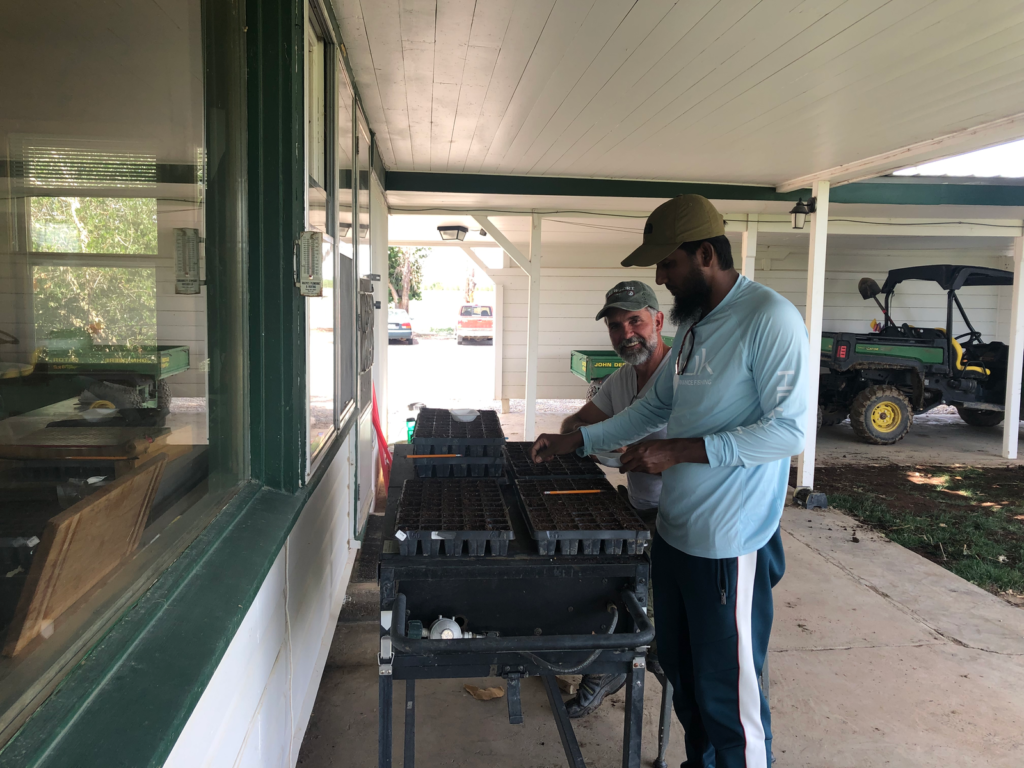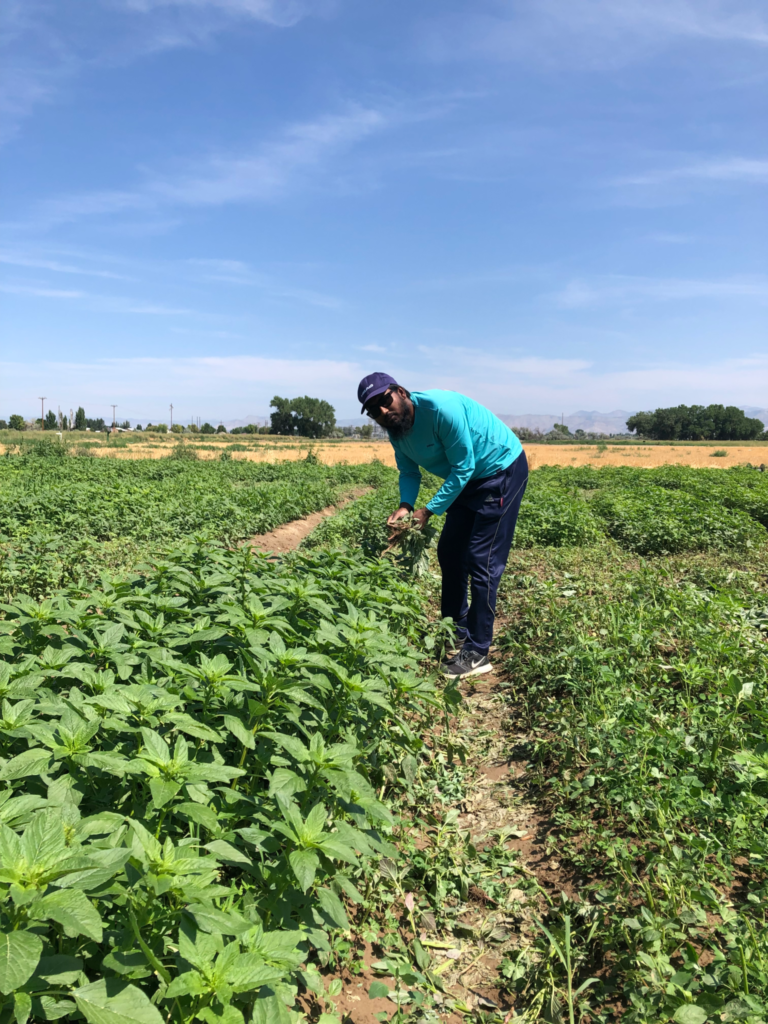Guest Author: Azmal Hossan, Doctoral Student, Sociology, Colorado State University and InTERFEWS Trainee

As a sociology doctoral student concentrating on social dimensions of the food-water nexus, I am aware that agricultural water resource management is fundamentally a complex problem. This complexity is exacerbated due to water scarcity fueled by climate change and increasing water demand from population growth and growing urbanization. Western Colorado Research Center-Grand Valley (WCRC-GV) is one of the three Colorado State University (CSU) agriculture experiment stations on the Western Slope of Colorado, a region that is highly water-stressed. Irrigation-based agricultural production is the region’s economic engine that is fully dependent on the Colorado River for both drinking and irrigation water. The 1,450 miles long transboundary river supplies drinking water for nearly 40 million people in seven U.S. western states and some parts of Mexico. The Colorado River also is the source of water for over 5 million acres of irrigated agricultural land. Due to rapid urban expansion and climate change, irrigated agriculture in the Colorado River Basin is confronted with a supply-demand imbalance. In 2021, the federal government declared the first water shortage on the Colorado River amid historic and prolonged drought in the region. With legal rights to 70% – 80% of the Colorado River surface water flows, irrigated farmers and ranchers of the region were asked to conserve water to share their agricultural water rights with other users, mainly with cities and municipalities. But the existence of legal, political, and cultural barriers can hinder them to conserve irrigated water. For example, the Doctrine of Prior Appropriation is the defining characteristic of Colorado water law under which water rights are determined by historical priority. As senior water right holders, agricultural producers are fearful that if they do not fully use their allotted water on time, they will lose their water rights. This fear is propagating water conflict between expanded urban settings and rural agricultural communities.
While participating in the CSU Extension Summer Internship at WCRC-GV, I understood this Agriculture Experimental Station (AES) has full potential to lead local communities in conserving agricultural water. The Center has been transforming its irrigation system from furrow to drip and conducting different irrigation experiments including planting sweet corn, hemp, and watermelon under the drip irrigation system. During my internship, I helped develop and fix a drip irrigation system as well as assisted with the science communication program using social media. In addition, WCRC-GV has been implementing an interdisciplinary project examining how a large irrigation canal system can administer a voluntary, temporary, and compensated conservation program in the Upper Colorado River Basin. The project is supported by the System Conservation Pilot Program of the Colorado Water Conservation Board. After one year, the project found a positive outcome on water conservation with participation from local agricultural producers. Here I remember three scenarios from my summer internship, denoting the station’s significance in water conservation efforts.
Scenario 1: Different Perspective
Azmal: “What are you doing here, Dr. Cabot?”
Dr. Cabot: “I am fixing the leaks in the drip system.”
Azmal: “You are a senior water expert with a Ph.D., right? Are you supposed to do it in such a manner?”
Dr. Cabot: “It is part of my job, Azmal, and I am doing it.”

This was the first conversation I made with my internship supervisor Dr. Perry Cabot. I met him early in the morning on June 2, 2021, the very first day of my internship, in one of the drip irrigation systems installed at the WCRC-GV. Lying in the dirt and muddy ground, he was fixing some leaks in the system installed to supply water to adjacent hemp and sweet corn plots. Dr. Cabot is a Water Resource Specialist with the Colorado Water Center and the Research and Extension Leader for WCRC-GV. He received his doctorate in Agricultural Engineering and Land Resources and received a Bachelors of Science in Civil Engineering. His research interests include innovative irrigation technologies, sustainable water resources management, and crop consumptive use evaluation. It may be normal for someone from the U.S. to see a water engineer with a doctorate fixing a drip irrigation system, but not for me. As an international doctoral student coming from Bangladesh, where 70 % of the population depends on irrigation-based agriculture for their survival, this scenario is quite unusual for me. With this experience, I realized that it does not matter whether an individual has a doctorate or not; rather it matters whether you are sincere and dedicated to your job. It also reminds me of the difference between professionalism in the working environment of two different cultures: the developed and developing world.
Scenario 2: Trust, Not Bugs
Local citizen: “Is there anyone who can help me identify whether these bugs are good or bad?”
Cordelia: “There is no entomologist here. But we can help you after talking to an entomologist.”
Azmal: “This is an Agriculture Experiment Station. Why is he here with the bugs?”
Cordelia: “People trust us so much.”
It was almost noon on June 2, 2021 and it was 90F outside. I was working in the field with Cordelia, a research assistant for Dr. Cabot and she was teaching me how to connect the tape with the manifold in a drip irrigation system. Suddenly we heard a voice asking for help to identify some bugs. We both looked back and saw a gentleman standing in front of an SUV in the middle of a plot prepared for sweet corn plantation, who was showing us a ziplock bag and asking whether the bugs were good or bad. I was a little surprised by the situation as we were at an irrigation Experiment Station doing different experiments on agricultural water conservation. When I asked Cordelia why he was there with the bugs, she simply responded that “local people trust us so much, and they think we can help them in every way.” Cordelia asked him to keep the bag with the bugs and she would speak with an entomologist. After this instance, I realized how the local communities trust this AES. Through the science communication training that I have been receiving over the last two years as a National Research Trainee of Interdisciplinary Training, Education and Research in Food-Energy-Water Systems (InTERFEWS) at CSU, I know that trust is a crucial component for science communication, especially if we want to highlight water-related science in water-stressed regions.

Scenario 3: Community Engagement
I worked as a social media manager of the WCRC during my internship, managed the Center’s Facebook and Twitter accounts and highlighted up-to-date science on agricultural water conservation with a special focus on the Western Slope of Colorado, different individuals working in the station as employees and stakeholders, collaborations with local, regional, and national agencies and research organizations. On June 21, 2021, I highlighted Cheryl Whiteman on Facebook and Twitter, acknowledging her voluntary contributions to the Center’s various operations for more than 15 years. Whiteman is a CSU alumnus who received her undergraduate degree in Occupational Therapy and Biological Science. She oversees a family-owned ranch on the Western Slope of Colorado. Her volunteer work is a great example of community engagement in the Center’s ongoing projects that is consistent with CSU’s land-grant mission. CSU’s Office of Engagement and Extension delivers on its land-grant mission by making the university’s educational programs, services and resources accessible to all, enabling individuals to act as agents of change and together build thriving communities. The post received the highest coverage in the history of the Center’s social media presence. From this instance, I realized that stakeholders who follow the Center’s social media platforms are more interested in the Center’s community engagement programs. As a sociologist, it was also encouraging to see that people are engaged in the stories covering human components.
Acknowledgment of Financial Support: I received financial support from CSU’s College of Liberal Arts, the InTERFEWS program, and the Western Colorado Research Center-Grand Valley to complete my 2021 CSU Extension Summer Internship. I am grateful for all of the support.
This article originally appeared in Colorado Water.
Colorado Water is the Colorado Water Center’s free publication devoted to highlighting water research and activities at CSU and throughout Colorado. View the Colorado Water archive here.